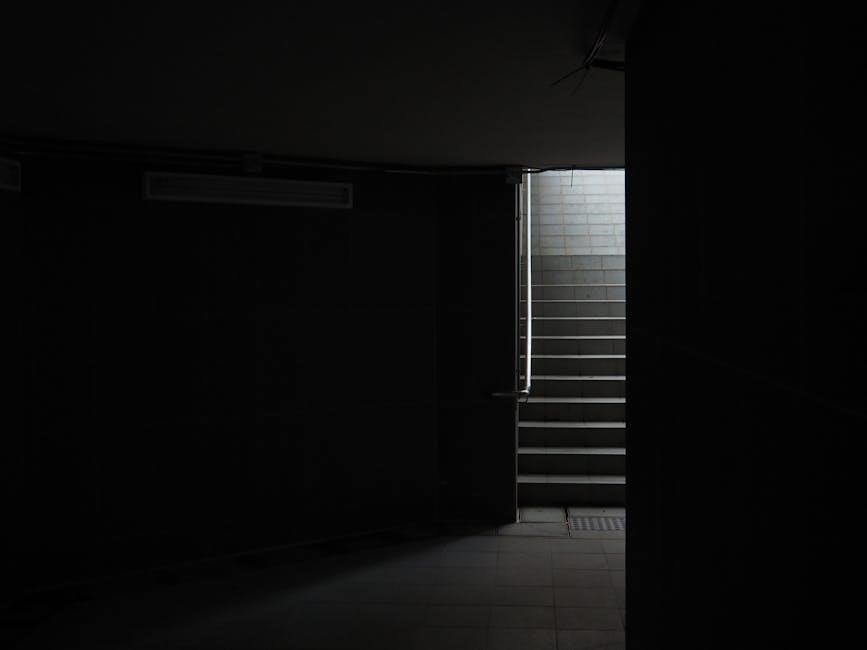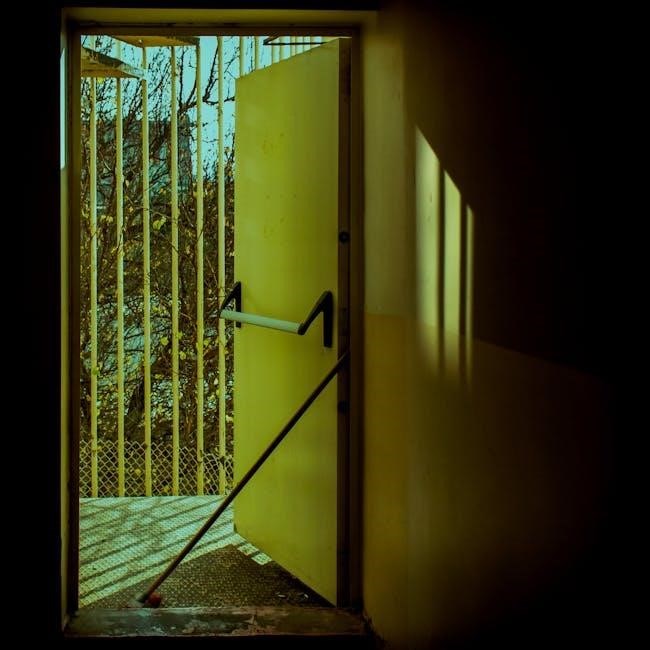Sartre’s No Exit: An Overview
Jean-Paul Sartre’s “No Exit,” initially performed in Paris in 1944, is a concise existentialist drama. The play explores themes of self-condemnation within a confined space, making it a searing philosophical statement.
Jean-Paul Sartre, a prominent figure in 20th-century philosophy and literature, is synonymous with existentialism. Existentialism, a person-centered philosophy, emphasizes individual freedom, responsibility, and the subjective experience of existence. Sartre’s works, including “No Exit,” explore the core tenets of this philosophy, highlighting the absence of predetermined essence and the burden of choice.
His atheistic existentialism posits that existence precedes essence, meaning individuals are born without inherent purpose and must define themselves through their actions. Sartre’s exploration of freedom and responsibility makes him a central figure in understanding existential thought, which is clearly manifested in “No Exit”.
His belief that God does not have roles to play is central to his philosophy.
The Historical Context of No Exit
“No Exit” premiered in Paris in May 1944, amidst the tumultuous backdrop of World War II and the German occupation. This context significantly shaped the play’s themes and reception. Performed just before the liberation of Paris, the play resonated with audiences grappling with questions of freedom, responsibility, and the nature of human relationships under extreme duress.
The atmosphere of confinement and moral ambiguity prevalent during the occupation found a stark reflection in the play’s claustrophobic setting and exploration of characters trapped by their own choices and the judgments of others. Sartre’s work offered a powerful commentary on the human condition in times of crisis.
The play reflects the mood in Paris at the time.

Plot and Characters of No Exit
Sartre’s “No Exit” features a confined room where three characters, Garcin, Inès, and Estelle, are trapped. The plot explores their interactions and the unfolding of their past sins, revealing their interconnected destinies.
Synopsis of the Play
Jean-Paul Sartre’s “No Exit” unfolds in a drawing-room in hell, where three recently deceased individuals—Garcin, Inès, and Estelle—find themselves confined together. They expect torture devices, but instead, they discover a simple room furnished in the Second Empire style, devoid of mirrors and windows. Initially, each character anticipates being alone or with a torturer, but they soon realize that their punishment is each other.
As they interact, the characters reveal their past sins and the reasons for their damnation. Garcin is a pacifist journalist, Inès a cynical lesbian, and Estelle a vain socialite. They grapple with their self-deceptions and attempts to justify their actions. The play examines how they confront their truths in the presence of others, ultimately leading to the famous declaration that “hell is other people.” They are forever trapped, forced to confront their realities.
Key Characters: Garcin, Inès, and Estelle
Garcin, a pacifist journalist, seeks validation for his courage but struggles with his past actions. He desires Estelle’s admiration to prove his heroism, yet he cannot escape the judgment of his cowardice. Inès, a cynical lesbian, possesses a sharp perception and sees through the self-deceptions of Garcin and Estelle. She craves Estelle’s love, but her honesty and critical nature make her an unwelcome mirror for the others.
Estelle, a vain socialite, desperately seeks male attention to validate her existence. She desires Garcin’s affection but is repulsed by Inès’s gaze. Each character embodies a specific form of existential bad faith. They are trapped in a cycle of desire and judgment, unable to escape their interdependence.

Themes in No Exit
“No Exit” explores existentialism, responsibility, self-deception, and the famous concept of “hell is other people.” The play delves into how individuals define themselves through the eyes of others, leading to inescapable conflict.

The Meaning of “Hell is Other People”
The iconic line, “Hell is other people,” from Sartre’s “No Exit,” encapsulates a central theme of existentialist philosophy explored within the play. It suggests that our perceptions of ourselves are profoundly shaped by the judgments and gazes of others. This dependence on external validation can become a source of torment, as individuals are constantly trying to conform to or rebel against the expectations imposed upon them.
In the play, the characters are trapped in a room together, forced to confront each other’s flaws and insecurities. They become each other’s torturers, constantly scrutinizing and judging one another. This mutual dependence and judgment create a psychological hell, where escape from the gaze of others is impossible. The characters are unable to achieve authentic selfhood because they are perpetually defined by the perceptions of those around them, highlighting Sartre’s view on the struggle for individual freedom and the burden of interpersonal relationships.
Existentialism and Responsibility
In “No Exit,” Sartre underscores the existentialist concept that existence precedes essence, meaning individuals are born without a predetermined purpose and must create their own meaning through choices. This freedom, however, comes with immense responsibility. The characters in the play are forced to confront the consequences of their past actions and the choices they made during their lives.
They cannot escape responsibility by blaming external forces or societal expectations. Instead, they must acknowledge their role in shaping their own identities and destinies. The closed room symbolizes the inescapable nature of their responsibility, as they are trapped with their past selves and the judgments of others. This emphasizes Sartre’s belief that individuals are entirely accountable for their actions and the creation of their own values in a world without inherent meaning or moral guidance.
Self-Deception and Bad Faith
“No Exit” explores self-deception and bad faith, core existentialist concepts. Bad faith involves denying one’s freedom and responsibility by adopting predetermined roles or values, thereby avoiding authentic self-creation. The characters exemplify this by clinging to false narratives about themselves.
Garcin, Inès, and Estelle each attempt to portray themselves in a favorable light, concealing their true motives and actions. Garcin wants to believe he is not a coward, Inès seeks validation through dominating others, and Estelle craves admiration to feel real. They deceive themselves and each other, creating a web of illusions to escape the harsh reality of their moral failings. This self-deception ultimately traps them in a cycle of suffering, as they cannot confront their true selves and embrace authentic existence within the confines of hell.

Analysis and Interpretation
Sartre’s “No Exit” offers a potent analysis of existentialist themes. The play’s setting and interactions provide a rich ground for interpreting concepts like freedom, responsibility, and the nature of human relationships.
The Symbolism of the Closed Room
The closed room in Sartre’s “No Exit” is far more than just a physical space; it represents the inescapable nature of hell and the characters’ psychological imprisonment. The room’s lack of mirrors, for instance, forces the characters to rely on each other’s gazes for self-perception, intensifying their mutual torment. This reliance creates a distorted sense of self, as their identities are shaped by the judgments and perceptions of others.
Furthermore, the absence of traditional torture devices highlights that hell is not a place of physical pain but rather a state of perpetual emotional and psychological anguish. The room’s claustrophobic atmosphere mirrors the characters’ inability to escape their past actions and the judgments of their fellow inmates. The constant presence of the others ensures that they can never truly be alone with themselves, forever trapped in a cycle of self-deception and mutual recrimination. This symbolic enclosure underscores Sartre’s existentialist ideas about responsibility and the inescapable nature of human existence.
The Role of the Gaze
In “No Exit,” the gaze, or the way characters perceive and judge each other, is central to Sartre’s exploration of hell. The characters are denied mirrors, forcing them to rely on the others for their self-image. This creates a dynamic where each person’s identity is constructed by the perceptions and judgments of their fellow inmates.
The gaze becomes a tool of torture, as the characters attempt to manipulate and control each other’s perceptions. Inès, for example, understands the power of the gaze and uses it to expose the others’ self-deceptions. Garcin seeks validation from Estelle to escape his cowardice, while Estelle craves Garcin’s desire to validate her own existence. This mutual dependence and judgment create a cycle of torment, as they are perpetually scrutinized and defined by each other’s views. Ultimately, the gaze underscores Sartre’s concept that “hell is other people,” as it is through the eyes of others that they experience their own personal hell.

No Exit as a Philosophical Statement
“No Exit” embodies Sartre’s atheistic existentialism, highlighting freedom, responsibility, and the absence of predetermined roles. The play posits that individuals define themselves through their choices in a deterministic setting.
Sartre’s Atheistic Existentialism
Sartre’s atheistic existentialism, a core tenet of “No Exit,” posits that existence precedes essence. Rejecting predetermined human nature, Sartre argues that individuals are born into the world without inherent purpose. It underscores that we are condemned to be free, bearing the full weight of responsibility for our choices. This perspective emphasizes individual agency and self-creation. The absence of God, for Sartre, doesn’t negate existence but rather amplifies human freedom and accountability.
Sartre’s belief that God is dead implies that God does not have roles to play in human affairs. We are free to define our values and create our own morality.
Freedom and Choice in a Deterministic Setting

Within the apparent determinism of “No Exit’s” confined hell, Sartre explores the paradoxical nature of freedom and choice. Though trapped in a room with no physical exit, the characters retain the freedom to define themselves through their actions and interactions. Even in this seemingly fixed environment, they are continually confronted with choices that shape their essence.
This notion highlights that even under oppressive conditions, human beings possess the power to exercise their freedom. The gaze of others, while a source of torment, also serves as a catalyst for self-awareness and the impetus to make choices, affirming their existence.

Legacy and Influence
“No Exit” has cemented its place in literature and popular culture, influencing various artistic works. Its famous line, “Hell is other people,” continues to resonate, sparking critical interpretations over time.

No Exit in Literature and Popular Culture
Jean-Paul Sartre’s “No Exit” has profoundly impacted literature and popular culture, extending its reach far beyond its initial Parisian debut. The play’s exploration of existential themes, particularly the notion that “Hell is other people,” has resonated deeply, inspiring numerous adaptations and references across various media.
The one-act play has been adapted into films, television episodes, and even musical compositions, demonstrating its enduring relevance. Its influence can be seen in works that explore interpersonal dynamics, moral responsibility, and the search for meaning in a seemingly absurd world. The claustrophobic setting and the characters’ inescapable self-awareness have become iconic tropes, frequently revisited and reinterpreted in contemporary art and entertainment. The play’s themes continue to challenge and provoke audiences, solidifying its legacy as a cornerstone of existentialist thought. “No Exit” remains a touchstone for understanding human relationships and the burden of individual freedom.
Critical Reception and Interpretations Over Time
“No Exit” initially garnered attention for its stark portrayal of existential themes and its daring exploration of human relationships in the context of post-war disillusionment. Critics have analyzed the play through various lenses, focusing on its philosophical underpinnings, its dramatic structure, and its symbolic representation of the human condition.
Early interpretations often emphasized the play’s atheistic existentialism, highlighting the characters’ freedom and responsibility in the absence of divine guidance. Over time, interpretations have broadened to encompass feminist perspectives, psychological analyses, and post-structuralist readings. Some critics have focused on the play’s depiction of power dynamics and the gaze, while others have explored its relevance to contemporary issues such as social alienation and the search for identity. The play continues to be a subject of scholarly debate, with new interpretations emerging as societal values and critical approaches evolve. Its enduring appeal lies in its ability to provoke thought and challenge conventional notions of morality and existence.

